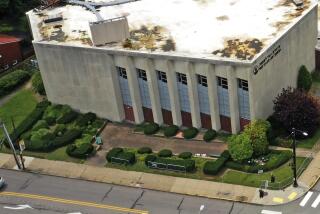Cynicism vs. a project from the heart
- Share via
CHRISTOPHER Hawthorne’s review of our design for the Flight 93 National Memorial in Shanksville, Pa., [“Reading Symbolism in the Sept. 11 Era,” Oct. 5] is characterized by a tone of cynical disdain. He chose to trivialize the design, omit a description of the selection process and limit coverage of the reactions to it.
That he missed many qualities of the design, so rooted in the landscape and its history, belies the fact that he actually visited the site. He misses the tranquillity, raw serenity and heroic scale of the land, all infusing the memorial design with expressive power.
Hawthorne avoids the deeper and unique sources of the design’s meaning and symbolism, and instead shows more interest in divisive, cultural projection. That there is a controversy indicates the many interpretations possible, but he ignores the strong and varied support the design has received.
Hawthorne neither describes the two-stage, open, international competition process, involving more than 1,000 entries, nor points out that the design was selected by two diverse juries comprising family, community and professional members. He ignores the role of the Mission Statement in the competition and why the jury judged this design as best. He ridicules the importance of the named elements (Tower of Voices, Sacred Ground, Approach Road, etc.), predominantly established by the competition guidelines to communicate to the public the many features in a 2,200-acre park, the first national park to be designed through an open competition.
In time, Hawthorne may come to understand why a memorial that allows visitors to reflect upon the heroic action of the passengers and crew of Flight 93 is better serving than a simulation or a symbol of action that ultimately demeans that action. He ignores the fact that this is not just a memorial but also a cemetery.
A project coming from the heart is too cynically dismissed as naive. The pseudo-intellectual critic misses the emotional responses to what he calls cool, abstract forms. He misses the level of intimate experience in the design’s bold, simple forms of landscape scale. He trivializes the role of minimalism in allowing varied personal access and interpretation. He disregards the active participation of the visitors to the site and how they will pay their respects, each in their own way, on their own terms.
Contrary to what Hawthorne would have you believe, the memorial is open to many levels of experience and ways of interaction -- by design.
I believe he owes us and the families of Flight 93 an apology.
More to Read
The biggest entertainment stories
Get our big stories about Hollywood, film, television, music, arts, culture and more right in your inbox as soon as they publish.
You may occasionally receive promotional content from the Los Angeles Times.










